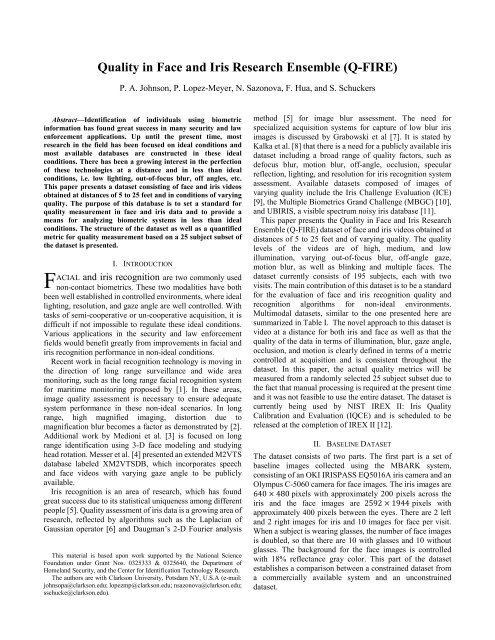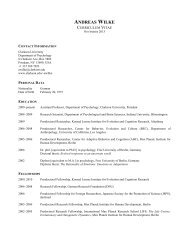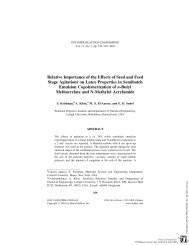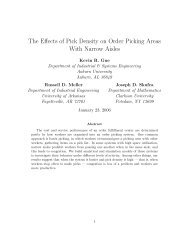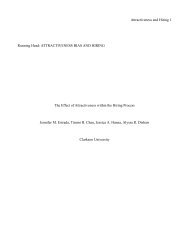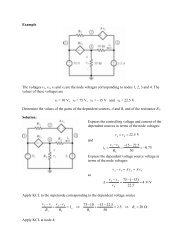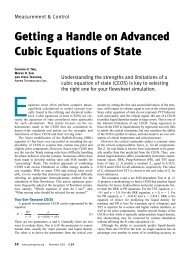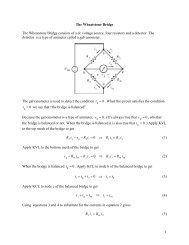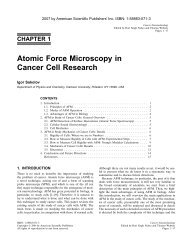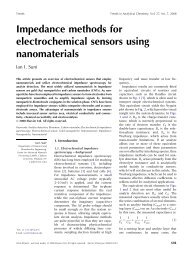Quality in Face and Iris Research Ensemble (Q ... - Clarkson University
Quality in Face and Iris Research Ensemble (Q ... - Clarkson University
Quality in Face and Iris Research Ensemble (Q ... - Clarkson University
You also want an ePaper? Increase the reach of your titles
YUMPU automatically turns print PDFs into web optimized ePapers that Google loves.
Abstract—Identification of <strong>in</strong>dividuals us<strong>in</strong>g biometric<br />
<strong>in</strong>formation has found great success <strong>in</strong> many security <strong>and</strong> law<br />
enforcement applications. Up until the present time, most<br />
research <strong>in</strong> the field has been focused on ideal conditions <strong>and</strong><br />
most available databases are constructed <strong>in</strong> these ideal<br />
conditions. There has been a grow<strong>in</strong>g <strong>in</strong>terest <strong>in</strong> the perfection<br />
of these technologies at a distance <strong>and</strong> <strong>in</strong> less than ideal<br />
conditions, i.e. low light<strong>in</strong>g, out-of-focus blur, off angles, etc.<br />
This paper presents a dataset consist<strong>in</strong>g of face <strong>and</strong> iris videos<br />
obta<strong>in</strong>ed at distances of 5 to 25 feet <strong>and</strong> <strong>in</strong> conditions of vary<strong>in</strong>g<br />
quality. The purpose of this database is to set a st<strong>and</strong>ard for<br />
quality measurement <strong>in</strong> face <strong>and</strong> iris data <strong>and</strong> to provide a<br />
means for analyz<strong>in</strong>g biometric systems <strong>in</strong> less than ideal<br />
conditions. The structure of the dataset as well as a quantified<br />
metric for quality measurement based on a 25 subject subset of<br />
the dataset is presented.<br />
F<br />
<strong>Quality</strong> <strong>in</strong> <strong>Face</strong> <strong>and</strong> <strong>Iris</strong> <strong>Research</strong> <strong>Ensemble</strong> (Q-FIRE)<br />
P. A. Johnson, P. Lopez-Meyer, N. Sazonova, F. Hua, <strong>and</strong> S. Schuckers<br />
I. INTRODUCTION<br />
ACIAL <strong>and</strong> iris recognition are two commonly used<br />
non-contact biometrics. These two modalities have both<br />
been well established <strong>in</strong> controlled environments, where ideal<br />
light<strong>in</strong>g, resolution, <strong>and</strong> gaze angle are well controlled. With<br />
tasks of semi-cooperative or un-cooperative acquisition, it is<br />
difficult if not impossible to regulate these ideal conditions.<br />
Various applications <strong>in</strong> the security <strong>and</strong> law enforcement<br />
fields would benefit greatly from improvements <strong>in</strong> facial <strong>and</strong><br />
iris recognition performance <strong>in</strong> non-ideal conditions.<br />
Recent work <strong>in</strong> facial recognition technology is mov<strong>in</strong>g <strong>in</strong><br />
the direction of long range surveillance <strong>and</strong> wide area<br />
monitor<strong>in</strong>g, such as the long range facial recognition system<br />
for maritime monitor<strong>in</strong>g proposed by [1]. In these areas,<br />
image quality assessment is necessary to ensure adequate<br />
system performance <strong>in</strong> these non-ideal scenarios. In long<br />
range, high magnified imag<strong>in</strong>g, distortion due to<br />
magnification blur becomes a factor as demonstrated by [2].<br />
Additional work by Medioni et al. [3] is focused on long<br />
range identification us<strong>in</strong>g 3-D face model<strong>in</strong>g <strong>and</strong> study<strong>in</strong>g<br />
head rotation. Messer et al. [4] presented an extended M2VTS<br />
database labeled XM2VTSDB, which <strong>in</strong>corporates speech<br />
<strong>and</strong> face videos with vary<strong>in</strong>g gaze angle to be publicly<br />
available.<br />
<strong>Iris</strong> recognition is an area of research, which has found<br />
great success due to its statistical uniqueness among different<br />
people [5]. <strong>Quality</strong> assessment of iris data is a grow<strong>in</strong>g area of<br />
research, reflected by algorithms such as the Laplacian of<br />
Gaussian operator [6] <strong>and</strong> Daugman’s 2-D Fourier analysis<br />
This material is based upon work supported by the National Science<br />
Foundation under Grant Nos. 0325333 & 0325640, the Department of<br />
Homel<strong>and</strong> Security, <strong>and</strong> the Center for Identification Technology <strong>Research</strong>.<br />
The authors are with <strong>Clarkson</strong> <strong>University</strong>, Potsdam NY, U.S.A (e-mail:<br />
johnsopa@clarkson.edu; lopezmp@clarkson.edu; nsazonova@clarkson.edu;<br />
sschucke@clarkson.edu).<br />
method [5] for image blur assessment. The need for<br />
specialized acquisition systems for capture of low blur iris<br />
images is discussed by Grabowski et al [7]. It is stated by<br />
Kalka et al. [8] that there is a need for a publicly available iris<br />
dataset <strong>in</strong>clud<strong>in</strong>g a broad range of quality factors, such as<br />
defocus blur, motion blur, off-angle, occlusion, specular<br />
reflection, light<strong>in</strong>g, <strong>and</strong> resolution for iris recognition system<br />
assessment. Available datasets composed of images of<br />
vary<strong>in</strong>g quality <strong>in</strong>clude the <strong>Iris</strong> Challenge Evaluation (ICE)<br />
[9], the Multiple Biometrics Gr<strong>and</strong> Challenge (MBGC) [10],<br />
<strong>and</strong> UBIRIS, a visible spectrum noisy iris database [11].<br />
This paper presents the <strong>Quality</strong> <strong>in</strong> <strong>Face</strong> <strong>and</strong> <strong>Iris</strong> <strong>Research</strong><br />
<strong>Ensemble</strong> (Q-FIRE) dataset of face <strong>and</strong> iris videos obta<strong>in</strong>ed at<br />
distances of 5 to 25 feet <strong>and</strong> of vary<strong>in</strong>g quality. The quality<br />
levels of the videos are of high, medium, <strong>and</strong> low<br />
illum<strong>in</strong>ation, vary<strong>in</strong>g out-of-focus blur, off-angle gaze,<br />
motion blur, as well as bl<strong>in</strong>k<strong>in</strong>g <strong>and</strong> multiple faces. The<br />
dataset currently consists of 195 subjects, each with two<br />
visits. The ma<strong>in</strong> contribution of this dataset is to be a st<strong>and</strong>ard<br />
for the evaluation of face <strong>and</strong> iris recognition quality <strong>and</strong><br />
recognition algorithms for non-ideal environments.<br />
Multimodal datasets, similar to the one presented here are<br />
summarized <strong>in</strong> Table I. The novel approach to this dataset is<br />
video at a distance for both iris <strong>and</strong> face as well as that the<br />
quality of the data <strong>in</strong> terms of illum<strong>in</strong>ation, blur, gaze angle,<br />
occlusion, <strong>and</strong> motion is clearly def<strong>in</strong>ed <strong>in</strong> terms of a metric<br />
controlled at acquisition <strong>and</strong> is consistent throughout the<br />
dataset. In this paper, the actual quality metrics will be<br />
measured from a r<strong>and</strong>omly selected 25 subject subset due to<br />
the fact that manual process<strong>in</strong>g is required at the present time<br />
<strong>and</strong> it was not feasible to use the entire dataset. The dataset is<br />
currently be<strong>in</strong>g used by NIST IREX II: <strong>Iris</strong> <strong>Quality</strong><br />
Calibration <strong>and</strong> Evaluation (IQCE) <strong>and</strong> is scheduled to be<br />
released at the completion of IREX II [12].<br />
II. BASELINE DATASET<br />
The dataset consists of two parts. The first part is a set of<br />
basel<strong>in</strong>e images collected us<strong>in</strong>g the MBARK system,<br />
consist<strong>in</strong>g of an OKI IRISPASS EQ5016A iris camera <strong>and</strong> an<br />
Olympus C-5060 camera for face images. The iris images are<br />
640 � 480 pixels with approximately 200 pixels across the<br />
iris <strong>and</strong> the face images are 2592 � 1944 pixels with<br />
approximately 400 pixels between the eyes. There are 2 left<br />
<strong>and</strong> 2 right images for iris <strong>and</strong> 10 images for face per visit.<br />
When a subject is wear<strong>in</strong>g glasses, the number of face images<br />
is doubled, so that there are 10 with glasses <strong>and</strong> 10 without<br />
glasses. The background for the face images is controlled<br />
with 18% reflectance gray color. This part of the dataset<br />
establishes a comparison between a constra<strong>in</strong>ed dataset from<br />
a commercially available system <strong>and</strong> an unconstra<strong>in</strong>ed<br />
dataset.
III. Q-FIRE DATASET<br />
The Q-FIRE dataset is set of face <strong>and</strong> iris videos spann<strong>in</strong>g 5<br />
to 25 feet <strong>and</strong> with various quantifiable degradations <strong>in</strong><br />
quality. Where possible, quality ranges from high to low were<br />
chosen based on published criteria. There are a total of 28<br />
face videos <strong>and</strong> 27 iris videos for each of 2 sessions per<br />
subject. Each session totals nearly 16 gigabytes.<br />
Dataset<br />
TABLE I<br />
OVERVIEW OF MULTIMODAL DATASETS<br />
Number of<br />
Subjects<br />
Number of<br />
Sessions<br />
XM2VTS [4] 295 4<br />
BiosecurID [13] 400 4<br />
BioSec [14] 250 2<br />
BIOMET [15] 91 3<br />
MCYT [16] 330 2<br />
Modalities<br />
<strong>Face</strong>,<br />
Voice<br />
<strong>Face</strong>,<br />
<strong>Iris</strong>,<br />
F<strong>in</strong>gerpr<strong>in</strong>t,<br />
Voice,<br />
H<strong>and</strong>,<br />
H<strong>and</strong> Writ<strong>in</strong>g,<br />
Signature,<br />
Keystroke<br />
<strong>Face</strong>,<br />
<strong>Iris</strong>,<br />
Voice<br />
<strong>Face</strong>,<br />
F<strong>in</strong>gerpr<strong>in</strong>t,<br />
Voice,<br />
H<strong>and</strong>,<br />
Signature<br />
F<strong>in</strong>gerpr<strong>in</strong>t,<br />
H<strong>and</strong> Writ<strong>in</strong>g<br />
Data<br />
Type<br />
Video<br />
Audio<br />
Image<br />
Audio<br />
Image<br />
Audio<br />
Image,<br />
Audio<br />
Image<br />
Videos were captured at five different distances from the<br />
cameras; 5, 7, 11, 15, <strong>and</strong> 25 feet. Each video is six seconds <strong>in</strong><br />
length, captured at a frame rate of ~25 frames per second. The<br />
videos that have variations <strong>in</strong> illum<strong>in</strong>ation to characterize<br />
contrast as well as the videos for motion blur were collected<br />
simultaneously for face <strong>and</strong> iris. The methods for the<br />
collection of all face <strong>and</strong> iris videos <strong>in</strong> this dataset are<br />
described below.<br />
A. <strong>Face</strong> Data<br />
<strong>Face</strong> videos are captured us<strong>in</strong>g a Canon VIXIA HFS100<br />
HD camcorder, 24 Mbps, 1920 � 1080 , 30p progressive<br />
camcorder.<br />
Resolution The ma<strong>in</strong> distances of <strong>in</strong>terest for face data are<br />
5, 15, <strong>and</strong> 25 feet, represent<strong>in</strong>g high, medium, <strong>and</strong> low<br />
resolution respectively. The st<strong>and</strong>ard for determ<strong>in</strong><strong>in</strong>g the<br />
resolution of a face image is to measure the number of pixels<br />
between the centers of the eyes [17]. For this dataset, the<br />
target value ranges for resolution are 350 to 800 pixels for<br />
high, 120 to 300 pixels for medium, <strong>and</strong> 70 to 100 pixels for<br />
low resolution, as specified by NIST [17].<br />
Illum<strong>in</strong>ation Three different levels of face contrast are<br />
achieved by three different illum<strong>in</strong>ation sett<strong>in</strong>gs. For high<br />
light, the overhead fluorescent lights are on <strong>in</strong> addition to two<br />
<strong>in</strong>c<strong>and</strong>escent 500 Watt studio lamps, arranged <strong>in</strong> two-po<strong>in</strong>t<br />
balance light<strong>in</strong>g, each at 30° �40°, diffused with umbrellas,<br />
<strong>and</strong> positioned 5 feet from the subject. The medium light<strong>in</strong>g<br />
condition is met by turn<strong>in</strong>g off the <strong>in</strong>c<strong>and</strong>escent light<strong>in</strong>g <strong>and</strong><br />
leav<strong>in</strong>g the overhead fluorescent light<strong>in</strong>g on. Low light<strong>in</strong>g is<br />
then achieved by turn<strong>in</strong>g off the overhead light<strong>in</strong>g <strong>and</strong> us<strong>in</strong>g<br />
only a s<strong>in</strong>gle <strong>in</strong>c<strong>and</strong>escent 500 Watt studio lamp with<br />
diffus<strong>in</strong>g umbrella, positioned at 90° to form a shadow on<br />
one side of the face. The target ranges for face contrast<br />
measurements are determ<strong>in</strong>ed by measur<strong>in</strong>g the width of the<br />
histogram of the face image <strong>and</strong> are greater than 128 gray<br />
levels for high light, less than 128 gray levels for medium<br />
light, <strong>and</strong> shadow<strong>in</strong>g on one side of the face to create a lower<br />
quality face image for low light.<br />
Out of Focus Blur In order to create face videos of vary<strong>in</strong>g<br />
out-of-focus blur, videos were captured at 5, 15, <strong>and</strong> 25 feet<br />
while adjust<strong>in</strong>g the focal plane of the camcorder across the<br />
full range over the 6 seconds of the video. A modulation<br />
transfer function (MTF) chart is placed beside the subject’s<br />
head to allow for the quantification of the level of blur <strong>in</strong> each<br />
frame of the video.<br />
<strong>Face</strong> Angles Variations <strong>in</strong> subject gaze angle are achieved<br />
us<strong>in</strong>g fixed mark<strong>in</strong>gs at each distance for the subject to look<br />
at. The different gaze angles are straight, left <strong>and</strong> right at 70°,<br />
<strong>and</strong> up <strong>and</strong> down at 30°. The subjects are asked to turn their<br />
head, keep<strong>in</strong>g their eyes <strong>in</strong> l<strong>in</strong>e with their face, <strong>and</strong> hold each<br />
position for approximately one second. <strong>Face</strong> gaze angle<br />
videos are captured at 5, 15, <strong>and</strong> 25 feet.<br />
Motion Blur Motion blur videos are captured at 7 <strong>and</strong> 15<br />
feet <strong>and</strong> consist of two different speeds of walk<strong>in</strong>g. The pace<br />
is set by a metronome for the subjects to step <strong>in</strong> sync with.<br />
The two different speeds are 66 beats per m<strong>in</strong>ute <strong>and</strong> 120<br />
beats per m<strong>in</strong>ute, which corresponds to approximately 1.5<br />
miles/hour <strong>and</strong> 2.75 miles/hour respectively. The camcorder<br />
is first set to manual focus while the subject is st<strong>and</strong><strong>in</strong>g <strong>in</strong><br />
position (7 or 15 feet) <strong>in</strong> order to set the focal plane <strong>and</strong> avoid<br />
any effects of the autofocus on the motion blur <strong>in</strong> the videos.<br />
Multiple <strong>Face</strong> To study the implications of facial<br />
recognition <strong>in</strong> a crowded environment, a video with multiple<br />
faces present is available. In this dataset there are videos for<br />
each subject with two additional <strong>in</strong>dividuals present <strong>in</strong> the<br />
scene, where the additional subjects take eight different<br />
positions around the subject of <strong>in</strong>terest to simulate a crowded<br />
environment. These videos are also captured at 5, 15, <strong>and</strong> 25<br />
feet.<br />
B. <strong>Iris</strong> Data<br />
<strong>Iris</strong> videos are captured with a Dalsa 4M30 <strong>in</strong>frared camera<br />
with a Tamron AF 70-300mm 1:4.5-5.6 LD DI lens. A Sigma<br />
APO 300-800mm F5.6 EX DG HSM lens is used at distances<br />
of 15 <strong>and</strong> 25 feet.<br />
Resolution The ma<strong>in</strong> distances of <strong>in</strong>terest for iris data are<br />
5, 7, <strong>and</strong> 11 feet, represent<strong>in</strong>g high, medium, <strong>and</strong> low<br />
resolution respectively. The st<strong>and</strong>ard for determ<strong>in</strong><strong>in</strong>g<br />
resolution of an iris image is measur<strong>in</strong>g the number of pixels<br />
across the diameter of the iris. The target ranges for iris<br />
resolution are 280 to 300 pixels for high, 200 to 220 pixels for<br />
medium, <strong>and</strong> 100 to 120 pixels for low. The high <strong>and</strong> low<br />
resolution ranges are those suggested by Daugman [4].<br />
Illum<strong>in</strong>ation <strong>Iris</strong> contrast is achieved by three different<br />
illum<strong>in</strong>ation sett<strong>in</strong>gs much like face contrast. The light<strong>in</strong>g<br />
used for the iris collection is made up of 10 LED based<br />
<strong>in</strong>frared light arrays (5 Watts each) mounted on a movable<br />
portal, positioned 2 feet from the subject. For the high<br />
light<strong>in</strong>g condition, 8 LED arrays are on, with 6 LED arrays
for medium light <strong>and</strong> 4 LED arrays for low light. For 15 <strong>and</strong><br />
25 feet, 10, 8, <strong>and</strong> 6 LED arrays are used for high, medium,<br />
<strong>and</strong> low light respectively. The measurements for iris contrast<br />
are taken at the average gray level difference across the<br />
sclera-iris <strong>and</strong> iris-pupil boundaries. The targets for these<br />
contrast measurements are summarized <strong>in</strong> Table II.<br />
TABLE II<br />
IRIS CONTRAST MEASUREMENT TARGETS IN NUMBER OF<br />
GRAY LEVELS ACROSS BOUNDARY<br />
Contrast Sclera-<strong>Iris</strong> Boundary <strong>Iris</strong>-Pupil Boundary<br />
High 70 60<br />
Medium 55 45<br />
Low 40 30<br />
Out of Focus Blur Variation <strong>in</strong> out-of-focus blur was<br />
obta<strong>in</strong>ed by turn<strong>in</strong>g the focus r<strong>in</strong>g of the lens dur<strong>in</strong>g capture<br />
of iris video. The focal plane is adjusted over a sufficient<br />
range from out of focus to <strong>in</strong> focus to back out of focus<br />
creat<strong>in</strong>g frames of vary<strong>in</strong>g blur to be selected from. This data<br />
is obta<strong>in</strong>ed <strong>in</strong> conjunction with the contrast data to save<br />
collection time <strong>and</strong> hard drive space. To quantify the amount<br />
of blur <strong>in</strong> each frame, a measure known as LoGscore can be<br />
implemented which is the average of the output of a<br />
Laplacian of Gaussian filter <strong>and</strong> can be used as the relative<br />
sharpness of each of the frames <strong>in</strong> a video. The Laplacian of<br />
Gaussian operator can be used to assess iris image quality <strong>in</strong><br />
terms of focus as described by [6].<br />
The effect of out-of-focus blur on iris recognition<br />
performance was studied from images captured with<br />
out-of-focus blur produced at acquisition. To quantify blur, a<br />
method was <strong>in</strong>troduced to quantify real out-of-focus blur <strong>and</strong><br />
compare it to the gold st<strong>and</strong>ard of the modulation transfer<br />
function (MTF) of a black/white st<strong>and</strong>ard chart. The<br />
proposed sharpness measure is based on the Laplacian of<br />
Gaussian (LoG) operator us<strong>in</strong>g non-segmented iris images<br />
from a video sequence with vary<strong>in</strong>g focus. This measure<br />
offers a good approximation of the gold st<strong>and</strong>ard MTF. The<br />
effect of the 9 blur levels on iris recognition performance was<br />
exam<strong>in</strong>ed. The results have shown that even for very blurry<br />
images (sharpness below 40%) there is sufficient <strong>in</strong>formation<br />
to achieve EER of 3-8.5%.<br />
Eye Angles Videos of variations <strong>in</strong> eye gaze angle are<br />
collected <strong>in</strong> similar manner to the face gaze angle videos. The<br />
subject is asked to look straight, left <strong>and</strong> right at 30°, <strong>and</strong> up<br />
<strong>and</strong> down at 30°, identified by fixed markers. For this case,<br />
unlike face, the subjects are asked to turn only their eyes,<br />
keep<strong>in</strong>g their heads fixed straight ahead. These videos are<br />
collected at 5, 7, <strong>and</strong> 11 feet.<br />
Motion Blur Motion blur videos are collected for iris at<br />
the same time as for face. All 10 LED arrays are on for the<br />
collection of the walk<strong>in</strong>g videos <strong>and</strong> the exposure time is<br />
reduced. This allows for the best tradeoff between<br />
illum<strong>in</strong>ation <strong>and</strong> motion blur.<br />
Eye Occlusion A video represent<strong>in</strong>g iris occlusion is<br />
collected at all distances at the high light<strong>in</strong>g condition. The<br />
subjects are asked to bl<strong>in</strong>k repeatedly dur<strong>in</strong>g the 6 seconds of<br />
video capture. Frames are then available at various amounts<br />
of eyelid closure.<br />
<strong>Iris</strong><br />
TABLE III<br />
DESCRIPTION OF FULL DATASET<br />
Distance (ft) Description<br />
Out-of-focus blur 5, 7, 11, 15, 25 Full range of blur<br />
Illum<strong>in</strong>ation 5, 7, 11, 15, 25 Low, Med, High<br />
Angles 5, 7, 11<br />
Straight, Left, Right,<br />
Up, Down<br />
Occlusion 5, 7, 11, 15, 25 6 seconds of bl<strong>in</strong>k<strong>in</strong>g<br />
Motion blur<br />
<strong>Face</strong><br />
7, 15 Slow/Fast Walk<strong>in</strong>g<br />
Out-of-focus blur 5, 15, 25 Full range of blur<br />
Illum<strong>in</strong>ation 5, 7, 11, 15, 25 Low, Med, High<br />
Angles 5, 15, 25<br />
Straight, Left, Right,<br />
Up, Down<br />
Occlusion 5, 15, 25 Multiple <strong>Face</strong>s<br />
Motion blur 7, 15 Slow/Fast Walk<strong>in</strong>g<br />
IV. RESULTS<br />
Verification of the target parameters <strong>in</strong> this dataset are<br />
demonstrated us<strong>in</strong>g a 25 subject subset. Many of the quality<br />
factors require manual measurements, <strong>and</strong> so an analysis of<br />
the entire dataset is not feasible at this po<strong>in</strong>t <strong>in</strong> time.<br />
Automated methods for quality measurement are currently<br />
be<strong>in</strong>g developed to allow for analysis of the entire dataset.<br />
The full dataset consists of 62% male subjects <strong>and</strong> 38%<br />
female subjects. The eye color distribution is 49% brown,<br />
27% blue, 18% hazel, <strong>and</strong> 8% green. All eye colors were<br />
self-reported by the subjects. The percentage of subjects over<br />
30 years of age is 22%. The percentage of subjects wear<strong>in</strong>g<br />
glasses is 21% <strong>and</strong> the percentage wear<strong>in</strong>g contact lenses is<br />
12%. Table IV summarizes the demographics of the 25<br />
subjects. Example frames from the face videos are presented<br />
<strong>in</strong> Figures 1-5 <strong>and</strong> examples of frames from iris videos<br />
presented <strong>in</strong> Figures 6-10.<br />
TABLE IV<br />
DEMOGRAPHICS FOR 25 SUBJECT SUBSET: SUBJECT<br />
DISTRIBUTIONS BY EYE COLOR<br />
Gender Total Brown Blue Hazel Green<br />
Male 15 5 7 2 1<br />
Female 10 6 3 1 0<br />
Two measures that were verified <strong>in</strong> this data are the<br />
resolution <strong>and</strong> contrast of the face <strong>and</strong> iris video frames. To<br />
analyze this, frames were extracted from the face <strong>and</strong> iris<br />
videos portray<strong>in</strong>g variations <strong>in</strong> illum<strong>in</strong>ation.<br />
For face, the segmentation of the face frames as well as the<br />
measurement of the number of pixel between the eyes for<br />
resolution was conducted us<strong>in</strong>g the FACEIT software. The<br />
contrast was then measured by determ<strong>in</strong><strong>in</strong>g the width of the
histogram of the face image us<strong>in</strong>g MATLAB. The average<br />
results for resolution us<strong>in</strong>g the 25 subject subset are presented<br />
<strong>in</strong> Figure 11, where it is shown that the resolution targets are<br />
met at 5, 15, <strong>and</strong> 25 for high, medium, <strong>and</strong> low respectively.<br />
The results for contrast measurements, averaged for the 25<br />
subjects are presented <strong>in</strong> Figure 12. It is observed that the<br />
contrast values for the low light<strong>in</strong>g condition are higher than<br />
the other two conditions, which is to be expected given the<br />
shadow on half of the face. The medium light<strong>in</strong>g condition at<br />
5 feet created slightly higher contrast values than expected,<br />
but the rema<strong>in</strong>der of the results for high <strong>and</strong> low contrast fall<br />
above <strong>and</strong> below a histogram width of 128 gray levels.<br />
For analysis of the iris videos, the most <strong>in</strong>-focus frame was<br />
selected from each video us<strong>in</strong>g the relative LoGscore<br />
measurement <strong>in</strong> the neighborhood of the iris be<strong>in</strong>g analyzed.<br />
The number of pixels across the iris was measured manually<br />
<strong>and</strong> the contrast was determ<strong>in</strong>ed by calculat<strong>in</strong>g the changes <strong>in</strong><br />
average gray level value across the sclera-iris <strong>and</strong> iris-pupil<br />
boundaries. All process<strong>in</strong>g of iris data was conducted <strong>in</strong><br />
MATLAB. The resolution results for the iris data, averaged<br />
over the 25 subjects are presented <strong>in</strong> Figure 13, where<br />
resolution measurements at 5, 7, <strong>and</strong> 11 feet are shown to<br />
closely match the target ranges. The iris contrast results,<br />
averaged for the 25 subjects are presented <strong>in</strong> Figures 14 <strong>and</strong><br />
15, as well as be<strong>in</strong>g presented <strong>in</strong> Table V. The iris contrast<br />
results are shown to be consistent across all distances <strong>and</strong> to<br />
match well to the targets. Table VI shows the st<strong>and</strong>ard<br />
deviations for the iris resolution <strong>and</strong> contrast measurements.<br />
The st<strong>and</strong>ard deviation for the contrast measurements is<br />
observed to be quite high. This is a result of a variation <strong>in</strong> iris<br />
contrast across different eye colors.<br />
Fig. 1. Example images from illum<strong>in</strong>ation videos; high (a), low (b), <strong>and</strong><br />
shadow (c).<br />
Fig. 2. Example images from out-of-focus blur video.<br />
Fig. 3. Example images from off-angle gaze video.<br />
TABLE V<br />
RESULTS FOR IRIS BOUNDARY REGION CONTRAST AND<br />
RESOLUTION MEASUREMENT AVERAGES<br />
Illum<strong>in</strong>ation Boundary 5 Feet 7 Feet 11 Feet<br />
High<br />
Medium<br />
Low<br />
Sclera-<strong>Iris</strong> 69 70 68<br />
<strong>Iris</strong>-Pupil 55 56 52<br />
Sclera-<strong>Iris</strong> 56 55 50<br />
<strong>Iris</strong>-Pupil 43 43 38<br />
Sclera-<strong>Iris</strong> 42 40 38<br />
<strong>Iris</strong>-Pupil 30 30 30<br />
Resolution 285 205 125<br />
TABLE VI<br />
STANDARD DEVIATION RESULTS FOR IRIS BOUNDARY<br />
REGION CONTRAST AND RESOLUTION MEASUREMENTS<br />
Illum<strong>in</strong>ation Boundary 5 Feet 7 Feet 11 Feet<br />
High<br />
Medium<br />
Low<br />
Sclera-<strong>Iris</strong> 24 25 28<br />
<strong>Iris</strong>-Pupil 19 16 19<br />
Sclera-<strong>Iris</strong> 22 19 19<br />
<strong>Iris</strong>-Pupil 16 15 15<br />
Sclera-<strong>Iris</strong> 14 14 16<br />
<strong>Iris</strong>-Pupil 10 10 11<br />
Resolution 21 13 8<br />
Fig. 4. Example images from motion blur videos; 7 feet slow (a), 7 feet fast<br />
(b), 15 feet slow (c), <strong>and</strong> 15 feet fast (d).<br />
Fig. 5. Example images from multiple faces video.
Fig. 6. Example images from iris illum<strong>in</strong>ation videos; high contrast (a),<br />
medium contrast (b), <strong>and</strong> low contrast (c)<br />
Fig. 7. Example images from iris out-of-focus blur video; high blur (a),<br />
medium blur (b), <strong>and</strong> low blur (c).<br />
Fig. 8. Example images from iris motion blur; slow wal<strong>in</strong>g at 7 feet (a), fast<br />
walk<strong>in</strong>g at 7 feet (b), slow walk<strong>in</strong>g at 15 feet (c), fast walk<strong>in</strong>g at 15 feet (d).<br />
Pixels Between Eyes<br />
350<br />
300<br />
250<br />
200<br />
150<br />
100<br />
50<br />
Fig. 9. Example images from iris angle video.<br />
Fig. 10. Example images of bl<strong>in</strong>k<strong>in</strong>g video.<br />
<strong>Face</strong> Resolution<br />
0<br />
5 15<br />
Distance (feet)<br />
25<br />
Fig. 11. <strong>Face</strong> resolution measurements averaged over 25 subjects for 5, 15,<br />
<strong>and</strong> 25 feet.<br />
Contrast<br />
280<br />
260<br />
240<br />
220<br />
200<br />
180<br />
160<br />
140<br />
120<br />
100<br />
<strong>Face</strong> Contrast<br />
High<br />
Low<br />
Shadow<br />
80<br />
5 15<br />
Distance (feet)<br />
25<br />
Fig. 12. <strong>Face</strong> contrast measurements averaged over 25 subjects for 5, 15, <strong>and</strong><br />
25 feet.<br />
Pixels Across the <strong>Iris</strong><br />
300<br />
250<br />
200<br />
150<br />
100<br />
50<br />
<strong>Iris</strong> Resolution<br />
0<br />
5 7<br />
Distance (feet)<br />
11<br />
Fig. 13. <strong>Iris</strong> resolution measurements averaged over 25 subjects for<br />
5, 7, <strong>and</strong> 11 feet.<br />
Contrast<br />
80<br />
70<br />
60<br />
50<br />
40<br />
Sclera-<strong>Iris</strong> Boundary<br />
High<br />
Medium<br />
Low<br />
30<br />
5 7<br />
Distance (feet)<br />
11<br />
Fig. 14. <strong>Iris</strong> contrast <strong>in</strong> sclera-iris boundary averaged over 25 subjects for 5,<br />
15, <strong>and</strong> 25 feet.
Contrast<br />
65<br />
60<br />
55<br />
50<br />
45<br />
40<br />
35<br />
30<br />
<strong>Iris</strong>-Pupil Boundary<br />
High<br />
Medium<br />
Low<br />
25<br />
5 7<br />
Distance (feet)<br />
11<br />
Fig. 15. <strong>Iris</strong> contrast <strong>in</strong> iris-pupil boundary averaged over 25 subjects for 5,<br />
15, <strong>and</strong> 25 feet.<br />
V. FUTURE WORK<br />
This database could be used for study of fusion of face <strong>and</strong><br />
iris <strong>in</strong> unconstra<strong>in</strong>ed environments at a distance. For<br />
example, presently the iris portion of the dataset is be<strong>in</strong>g used<br />
to assess measurement of iris quality <strong>in</strong> the NIST IREX II:<br />
<strong>Iris</strong> <strong>Quality</strong> Calibration <strong>and</strong> Evaluation [12]. By controll<strong>in</strong>g<br />
quality at acquisition <strong>in</strong> a measureable way, <strong>in</strong>dependent<br />
measures of iris image quality can be assessed. Ultimately,<br />
knowledge of quality can <strong>in</strong>form “smart” fusion of face <strong>and</strong><br />
iris images, particularly when video collection of images is<br />
performed which can require massive data process<strong>in</strong>g.<br />
The next step <strong>in</strong> analysis of this database is to extend<br />
measurement of quality factors over the whole set.<br />
Correspond<strong>in</strong>g match scores will then be computed,<br />
compar<strong>in</strong>g the distance images to basel<strong>in</strong>e. The l<strong>in</strong>k between<br />
quality <strong>and</strong> performance can then be assessed.<br />
A future plan of this study is to extend the dataset by hav<strong>in</strong>g<br />
around 100 of the subjects that participated <strong>in</strong> the current data<br />
collection return to form a supplementary dataset of<br />
non-cooperative biometrics at a distance. This new set would<br />
consist of face <strong>and</strong> iris videos obta<strong>in</strong>ed <strong>in</strong> a less constra<strong>in</strong>ed<br />
environment, i.e. longer st<strong>and</strong>off distance, outdoor collection,<br />
<strong>and</strong> hav<strong>in</strong>g the subjects perform unconstra<strong>in</strong>ed tasks.<br />
VI. CONCLUSION<br />
<strong>Quality</strong> assessment of face <strong>and</strong> iris data is an important<br />
factor <strong>in</strong> the field of biometric research. This paper presents a<br />
face <strong>and</strong> iris video dataset captured at a distance <strong>in</strong>corporat<strong>in</strong>g<br />
multiple quality degradations <strong>in</strong> face <strong>and</strong> iris data. This 6.24<br />
terabyte dataset will serve to evaluate face <strong>and</strong> iris<br />
recognition algorithms <strong>in</strong> terms of performance based on<br />
variations <strong>in</strong> quality.<br />
[1]<br />
REFERENCES<br />
Xiaokun Li, Genshe Chen, Qiang Ji, <strong>and</strong> E. Blasch, “A<br />
non-cooperative long-range biometric system for maritime<br />
[2]<br />
surveillance,” Pattern Recognition, 2008. ICPR 2008. 19th<br />
International Conference on, 2008, pp. 1-4.<br />
Y. Yao, B.R. Abidi, N.D. Kalka, N.A. Schmid, <strong>and</strong> M.A. Abidi,<br />
“Improv<strong>in</strong>g long range <strong>and</strong> high magnification face recognition:<br />
Database acquisition, evaluation, <strong>and</strong> enhancement,” Computer<br />
Vision <strong>and</strong> Image Underst<strong>and</strong><strong>in</strong>g, vol. 111, Aug. 2008, pp. 111-125.<br />
[3] G. Medioni, J. Choi, Cheng-Hao Kuo, <strong>and</strong> D. Fidaleo, “Identify<strong>in</strong>g<br />
Noncooperative Subjects at a Distance Us<strong>in</strong>g <strong>Face</strong> Images <strong>and</strong><br />
Inferred Three-Dimensional <strong>Face</strong> Models,” Systems, Man <strong>and</strong><br />
Cybernetics, Part A: Systems <strong>and</strong> Humans, IEEE Transactions on,<br />
vol. 39, 2009, pp. 12-24.<br />
[4] K. Messer, J. Matas, J. Kittler, J. Lütt<strong>in</strong>, <strong>and</strong> G. Maitre,<br />
“XM2VTSDB: The Extended M2VTS Database,” In Second<br />
International Conference on Audio <strong>and</strong> Video-based Biometric<br />
Person Authentication, 1999, pp. 72-77.<br />
[5] J. Daugman, “How iris recognition works,” Image Process<strong>in</strong>g. 2002.<br />
Proceed<strong>in</strong>gs. 2002 International Conference on, 2002, pp. I-33-I-36<br />
vol.1.<br />
[6] J. Wan, X. He, <strong>and</strong> P. Shi, “An <strong>Iris</strong> Image <strong>Quality</strong> Assessment<br />
Method Based on Laplacian of Gaussian Operation,” May. 2007, pp.<br />
248-251.<br />
[7] K. Grabowski, W. Sankowski, M. Zubert, <strong>and</strong> M. Napieralska,<br />
“Focus Assessment Issues <strong>in</strong> <strong>Iris</strong> Image Acquisition System,” Mixed<br />
Design of Integrated Circuits <strong>and</strong> Systems, 2007. MIXDES '07. 14th<br />
International Conference on, 2007, pp. 628-631.<br />
[8] N.D. Kalka, J. Zuo, N.A. Schmid, <strong>and</strong> B. Cukic, “Image quality<br />
assessment for iris biometric,” Biometric Technology for Human<br />
Identification III, P.J. Flynn <strong>and</strong> S. Pankanti, Eds., Orl<strong>and</strong>o<br />
(Kissimmee), FL, USA: SPIE, 2006, pp. 62020D-11.<br />
[9] “<strong>Iris</strong> Challenge Evaluation,” National Institute of St<strong>and</strong>ards <strong>and</strong><br />
Technology, http://iris.nist.gov/ICE.<br />
[10] “Multiple Biometrics Gr<strong>and</strong> Challenge,” National Institute of<br />
St<strong>and</strong>ards <strong>and</strong> Technology.<br />
[11] H. Proença <strong>and</strong> L.A. Alex<strong>and</strong>re, “UBIRIS : A noisy iris image<br />
database,” vol. 3617, 2005, pp. 970-977.<br />
[12] “IREX <strong>Iris</strong> Exchange,” National Institute of St<strong>and</strong>ards <strong>and</strong><br />
Technology, http://iris.nist.gov/IREXII.<br />
[13] J. Fierrez, J. Galbally, J. Ortega-Garcia, M.R. Freire, F.<br />
Alonso-Fern<strong>and</strong>ez, D. Ramos, D.T. Toledano, J.<br />
Gonzalez-Rodriguez, J.A. Siguenza, J. Garrido-Salas, E. Anguiano,<br />
G. Gonzalez-de-Rivera, R. Ribalda, M. Faundez-Zanuy, J.A. Ortega,<br />
V. Cardeñoso-Payo, A. Viloria, C.E. Vivaracho, Q.I. Moro, J.J.<br />
Igarza, J. Sanchez, I. Hernaez, C. Orrite-Uruñuela, F.<br />
Mart<strong>in</strong>ez-Contreras, <strong>and</strong> J.J. Gracia-Roche, “BiosecurID: a<br />
multimodal biometric database,” Pattern Analysis <strong>and</strong> Applications,<br />
vol. 13, 2009, pp. 235-246.<br />
[14] J. Fierrez, J. Ortega-Garcia, D. Torre Toledano, <strong>and</strong> J.<br />
Gonzalez-Rodriguez, “Biosec basel<strong>in</strong>e corpus: A multimodal<br />
biometric database,” Pattern Recognition, vol. 40, Apr. 2007, pp.<br />
1389-1392.<br />
[15] S. Garcia-Salicetti, C. Beumier, G. Chollet, B. Dorizzi, J.L.L.<br />
Jard<strong>in</strong>s, J. Lunter, Y. Ni, <strong>and</strong> D. Petrovska-Delacrétaz, “BIOMET: a<br />
multimodal person authentication database <strong>in</strong>clud<strong>in</strong>g face, voice,<br />
f<strong>in</strong>gerpr<strong>in</strong>t, h<strong>and</strong> <strong>and</strong> signature modalities,” Proceed<strong>in</strong>gs of the 4th<br />
<strong>in</strong>ternational conference on Audio- <strong>and</strong> video-based biometric<br />
person authentication, Guildford, UK: Spr<strong>in</strong>ger-Verlag, 2003, pp.<br />
845-853.<br />
[16] J. Ortega-Garcia, J. Fierrez-Aguilar, D. Simon, J. Gonzalez, M.<br />
Faundez-Zanuy, V. Esp<strong>in</strong>osa, A. Satue, I. Hernaez, J. Igarza, C.<br />
Vivaracho, D. Escudero, <strong>and</strong> Q. Moro, “MCYT basel<strong>in</strong>e corpus: a<br />
bimodal biometric database,” Vision, Image <strong>and</strong> Signal Process<strong>in</strong>g,<br />
IEE Proceed<strong>in</strong>gs -, vol. 150, 2003, pp. 395-401.<br />
[17] “NIST-ITL 1-2007 Data Format for the Interchange of F<strong>in</strong>gerpr<strong>in</strong>t,<br />
Facial, & Other Biometric Information – Part 1,” National Institute of<br />
St<strong>and</strong>ards <strong>and</strong> Technology, May. 2007,<br />
http://f<strong>in</strong>gerpr<strong>in</strong>t.nist.gov/st<strong>and</strong>ard/Approved-Std-20070427.pdf.


